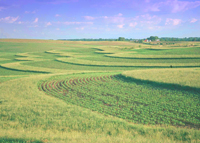|
| |

Change Needed in Applying Fertilizer to Perennial Grassland
 In
a January-February 2006, Journal of Soil and Water Conservation
article,
Incorporating Granular Inorganic Fertilizer into Perennial Grassland Soils to
Improve Water Quality, D.H. Pote and other researchers recommend
incorporating fertilizer into the soil versus the common practice of applying
fertilizer on the surface of grass and rangeland. Beef and dairy producers
need forage to feed their livestock and they often apply inorganic fertilizers
on pastureland to increase forage growth. In
a January-February 2006, Journal of Soil and Water Conservation
article,
Incorporating Granular Inorganic Fertilizer into Perennial Grassland Soils to
Improve Water Quality, D.H. Pote and other researchers recommend
incorporating fertilizer into the soil versus the common practice of applying
fertilizer on the surface of grass and rangeland. Beef and dairy producers
need forage to feed their livestock and they often apply inorganic fertilizers
on pastureland to increase forage growth.
Pote and his fellow researchers re-emphasized that the more common manner of
distributing the fertilizer-spreading granules on the surface leaves the
fertilizer vulnerable to runoff and loss into the atmosphere as ammonia.
They hypothesized that a knifing technique gets the fertilizer closer to the
roots and minimize the two negative impacts of having the fertilizer laying on
the ground’s surface. To look at the effect knifing-in the fertilizer, Pote et
al. studied the yield and runoff water quality on plots with eight to ten
percent slope of silt loam soil with well-established bermudagrass. They
favored knifing the soil and spreading the 13-13-13-fertilizer over the top as
an attractive option since current equipment could achieve the cuts and
spreading-with-knifing to move the fertilizer down into the cuts. The
cuts were made every eight inches across the plot and three inches deep. The
plots had simulated and natural rainfall throughout the study.
The researchers found that even though knifing the soil and spreading the
fertilizer over the top was easy to apply and slowed runoff, it did not
provide the best safety for fertilizer being carried. The yield from this
method was not negatively impacted by cutting the soil and spreading over the
top, but yield was not significantly improved either unless the fertilizer is
incorporated into the soil. Incorporating the fertilizer into the soil also
was the optimum in water quality of runoff. On plots where the fertilizer was
incorporated, the nutrient concentrations and loads in runoff were decreased
by 90 percent.
Pote et al. also found that both yield and runoff water quality were improved
when fertilizer is incorporated into the soil. This meant that field equipment
currently under development to mechanize this process is needed now.
Ultimately, the easier process of cutting and spreading on top of the
pastureland did not prove worthwhile.
Your contact is Deb Happe, Soil and
Water Conservation Society, at 515-289-2331, ext. 26.
| | |
